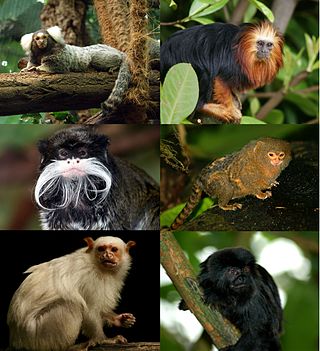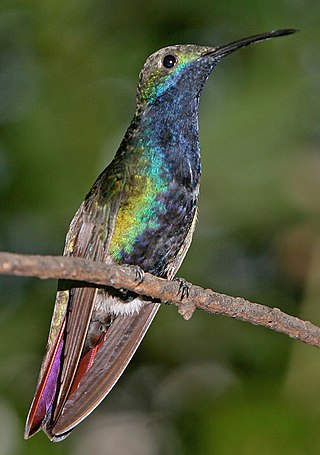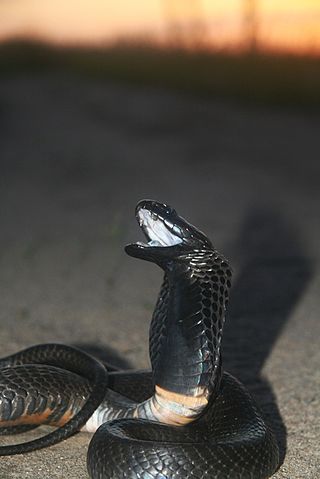
The Callitrichidae are a family of New World monkeys, including marmosets, tamarins, and lion tamarins. At times, this group of animals has been regarded as a subfamily, called the Callitrichinae, of the family Cebidae.

The black-necked grebe or eared grebe is a member of the grebe family of water birds. It was described in 1831 by Christian Ludwig Brehm. Its breeding plumage features distinctive ochre-coloured feathers which extend behind its eye and over its ear coverts. The rest of the upper parts, including the head, neck, and breast, are coloured black to blackish brown. The flanks are tawny rufous to maroon-chestnut, and the abdomen is white. In its non-breeding plumage, this bird has greyish-black upper parts, including the top of the head and a vertical stripe on the back of the neck. The flanks are also greyish-black. The rest of the body is a white or whitish colour. The juvenile has more brown in its darker areas. This species is present in parts of Africa, Eurasia, and the Americas.

The black-necked weaver is a resident breeding bird species in much of central Africa from Cameroon in the west to Kenya and southern Somalia in the east.

The black-throated mango is a species in subfamily Polytminae of the hummingbird family Trochilidae. It is found in Panama, in every mainland South American country except Chile, and in Trinidad and Tobago.

The flannel moths or crinkled flannel moths are a family of insects.

A "spitting" cobra is any of several species of cobra that can intentionally, defensively shoot their venom directly from their fangs. This substance has two functions, with the first being as venom that can be absorbed via the victim’s eyes, mouth, or nose, and secondly as a toxungen, which can be sprayed on the target surface. Their ability to target and shoot venom is utilised in several different ways, self-defense being the most common instance. Studies have shown that the targets are far from random; rather, spitting cobras consciously take aim, directing their spray as close as possible to the eyes and face of an aggressor.

The black-necked crane is a medium-sized crane in Asia that breeds on the Tibetan Plateau and remote parts of India and Bhutan. It is 139 cm (55 in) long with a 235 cm (7.71 ft) wingspan, and it weighs 5.5 kg (12 lb). It is whitish-gray, with a black head, red crown patch, black upper neck and legs, and white patch to the rear of the eye. It has black primaries and secondaries. Both sexes are similar. Some populations are known to make seasonal movements. It is revered in Buddhist traditions and culturally protected across much of its range. A festival in Bhutan celebrates the bird while the Indian union territory of Ladakh has designated it as the state bird.

The black-mantled tamarin, Leontocebus nigricollis, is a species of saddle-back tamarin from the northwestern Amazon in far western Brazil, southeastern Colombia, north-eastern Peru and eastern Ecuador.

The Indian hare, also known as the black-naped hare, is a common species of hare native to the Indian subcontinent, and Java. Its habitat in Java is in rocky highlands.

The black-collared hawk is a species of bird of prey in the family Accipitridae. It is monotypic within the genus Busarellus. It has a widespread range of presence, from western Mexico to Uruguay. Its natural habitats are subtropical or tropical moist lowland forests, subtropical or tropical swamps, and swamps.

The black-collared starling is a species of starling in the family Sturnidae. Its plumage is black and white, with a black collar. It is found in southern China and most of mainland Southeast Asia, and has been introduced to Taiwan, Malaysia and Singapore. Its habitats include grassland, dry forest and human settlements. The International Union for Conservation of Nature (IUCN) has assessed it as being of least concern.

The Madagascar buttonquail is a species of bird in the buttonquail family, Turnicidae, that is endemic to Madagascar and a few small islands nearby. It is a ground-dwelling species with an unusual breeding biology in which the sexual dimorphism is reversed, with female being more brightly coloured than the male and it is the male that incubates the eggs and mainly cares for the young.

The yellow-bellied seedeater is a species of bird in the family Thraupidae, formerly placed with the American sparrows in the Emberizidae.

Naja ashei, commonly known as Ashe's spitting cobra or the giant spitting cobra, is a species of venomous snake in the family Elapidae. The species is native to Africa. It is the world's largest species of spitting cobra.

The black-necked spitting cobra is a species of spitting cobra found mostly in sub-Saharan Africa. They are moderately sized snakes that can grow to a length of 1.2 to 2.2 m in length. Their coloration and markings can vary considerably. They prey primarily on small rodents. They possess medically significant venom, although the mortality rate for untreated bites on humans is relatively low. Like other spitting cobras, they can eject venom from their fangs when threatened. The cytotoxic venom irritates the skin, causing blisters and inflammation, and can cause permanent blindness if the venom makes contact with the eyes and is not washed off.
Malmella is a genus of moths in the family Megalopygidae described by Paul Dognin in 1914.
Ceralocyna is a genus of beetles in the family Cerambycidae, containing the following species:

Tylosis is a genus of beetles in the family Cerambycidae, containing the following species:
Ceralocyna nigricollis is a species of beetle in the family Cerambycidae. It was described by Ratcliffe in 1911
Malmella strigiprima is a moth of the Megalopygidae family. It was described by Paul Dognin in 1914. It is found in Colombia.















